Nāṣir, the Hebrew Littérateur
“I am the Hebrew littérateur / they call me Nāṣir / eloquent and witty in every matter….”1
אנא אלאדיב אלעברי אלדי אסמי נאצר פי גמיע אלאשגאל לי כלאם גיד נאדר

“I am the dhimmī untaught poet / my name is Nāṣir / I’ve studded my verse with pearls….”2
ואנא הו אלאדיב אלדמי אלכאמי ונאצר אסמי רצעת אלדרר פי נצמי
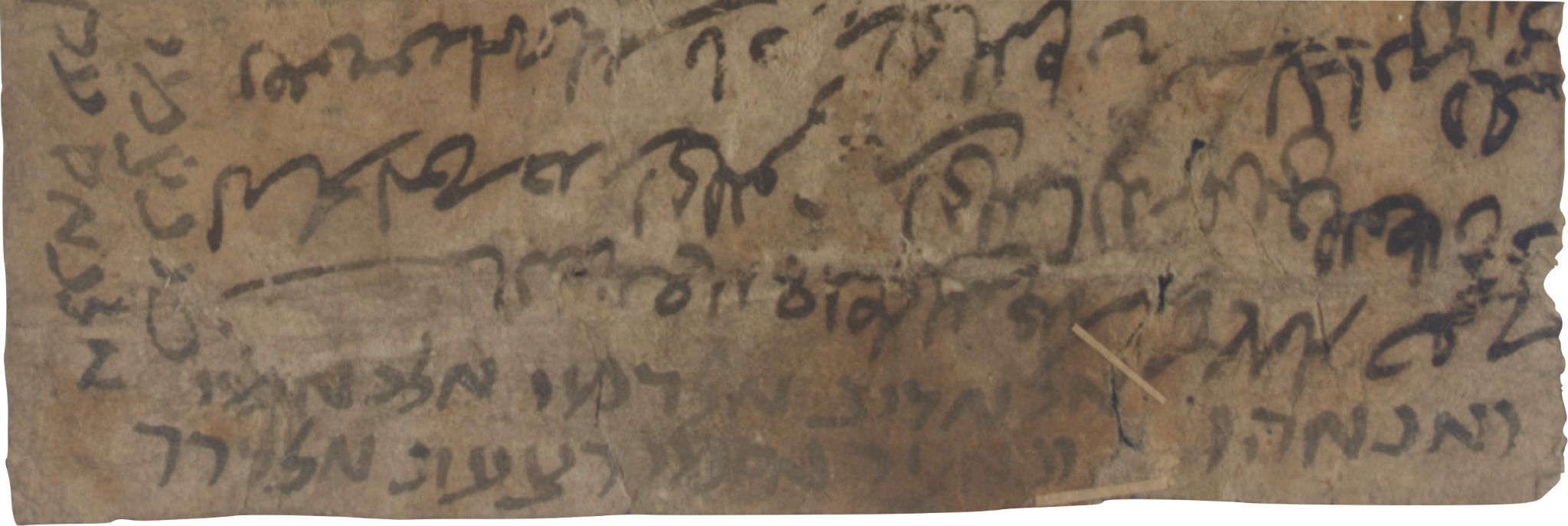
Nāṣir, the self-proclaimed “Hebrew littérateur,” enjoyed a heyday as an eclectic poet in Mamluk Egypt ca. 1300 CE only to lapse into obscurity after his death. His works, approximately two-thirds in Judaeo-Arabic and one-third in Hebrew, were probably not crafted to build a literary legacy. They seem rather to be the ephemera and occasional pieces of a man who made a living as a performer, singing at weddings and circumcisions and entertaining in the marketplace.
To date, I have found some 40 Genizah fragments written in his distinctive hand, the majority of them containing poetry or rhymed prose of his own composition.3 His thematic repertoire is wide. He composes solemn dirges and festive songs, erotic odes, parodic medical prescriptions for the lovesick, lampoons of stingy hosts and tactless guests, retellings of biblical tales, a jingle about basketmakers and fava bean vendors (“if you pop these beans in your mouth, you’ll be perfumed with fragrance and freshness”), and poetic debates between mind-altering substances.4
In this Fragment of the Month, I will contextualize Nāṣir’s literary oeuvre, sketch the silhouette of his life and social context, and conclude with an excerpt from one of his more delightful works.
The contribution of the Cairo Genizah to the study of Hebrew liturgical and secular poetry cannot be overstated. Countless poems—and numerous poets—are solely attested in manuscripts from the Genizah and related troves such as the Firkovich Collection in St. Petersburg. Yet only in recent years, thanks largely to Mohamed A. H. Ahmed and Rachel Hasson, have scholars begun to examine the Genizah’s vast riches of Judaeo-Arabic (not to speak of Arabic) poetry.5 The neglect of the Judaeo-Arabic poetry found in the Genizah, often described in catalogues as piyyuṭ or liturgical poetry, is consistent with the wider trend in Judaeo-Arabic literary studies of relegating popular poetry to passing mentions and footnotes.6
The chief exception to this rule (outside of Genizah studies) is the scholarship on the “Shabazian” school of poetry in Yemen. As far back as the 15th century, Yemeni Jewish poets began to place Hebrew and Judaeo-Arabic on an equal footing, mixing the two languages together in one and the same poem.7 This style reached its efflorescence in the days of Shalom Shabazi (d. after 1679), who became the most revered poet of Yemeni Jews. The vacuum of research on medieval Judaeo-Arabic verse has led scholars to treat the Judaeo-Arabic portion of Shabazian verse as sui generis, when in fact it draws from a much older—albeit mostly unknown—tradition within Jewish literary history, the same tradition that gave rise to Nāṣir, the Hebrew Littérateur.
Nāṣir’s diverse themes demand diverse registers. He can write in an elevated style when he pleases, and he is also the poet who rhymes “stoner” (masṭūl) with “ghoul” (ghūl).8 Though he does not reach the pinnacles of vulgarity of his contemporary Ibn Dāniyāl (ca. 1248–1310), the two characters have much in common, and it is not far-fetched to imagine that they might have crossed paths or even known each other.9 One intriguing intersection is that Ibn Dāniyāl earned part of his living as an eye doctor, and while we do not know if Nāṣir had any additional trade, he frequently draws on the imagery of medicines, physicians, and eye diseases.10
It is worth noting that Nāṣir is far from the only author attested in the Genizah who produced vernacular, lowbrow, and/or humorous literature in Judaeo-Arabic. Rachel Hasson has published an early Ottoman-era debate poem between “the city slicker and the hillbilly” (al-miṣrī wa-l-rīfī), composed by a wandering cantor named Sulaymān.11 To mention only two other unpublished and barely studied manuscripts, T-S NS 99.34 is a litany of praises for God, Who rounded the walnut, Who placed the whales in the sea, and Who created all sorts of humans—those with their noses between their eyes, and those with their heads between their ears. And T-S Ar.6.12 contains a rollicking mock epic in which Bouncer, the Amir of the Mice, musters the mice of the world to vanquish Flapper b. Grabber, the King of the Pigeons, who slew his father Abū Fasād.12
Returning to Nāṣir: how can we unearth any details about his life, given that no documentary fragments have surfaced in his handwriting and that his poetry preserves only a modicum of biographical information? I propose that we can shade in the contours of his life by examining his reuses of earlier documentary material and by identifying the earlier literary works that he copied in his hand. Every such fragment provides a data point linking him to specific times, places, and people, and to the constellation of his literary influences and interests.
My first lead was T-S 12.537, a mock medical prescription for lovers written in Judaeo-Arabic rhymed prose. To my knowledge, this is the only one of Nāṣir’s compositions that has drawn the attention of previous scholars. S. D. Goitein transcribed it for his own records and called it “rhymed advice for lovers (ʿāshiqīn), no doubt copied from [an] Arabic book.”13 As Nāṣir does not sign this text, and the religious allusions are far more Islamic than they are Jewish, Goitein’s suggestion that Nāṣir copied (or adapted) it from another source is not implausible.14
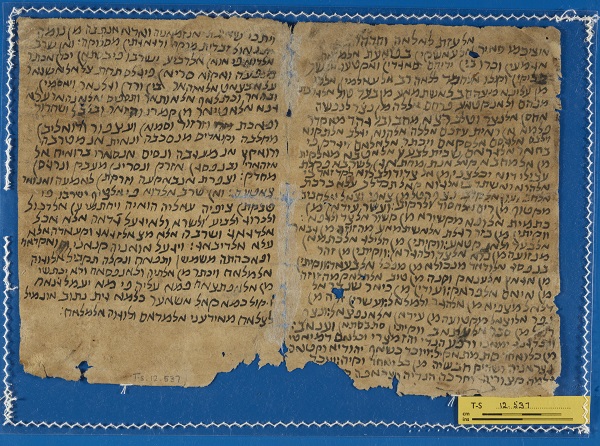
T-S 12.537 recto
On the other side of the manuscript, we find the lower half of a ketubba (marriage contract):
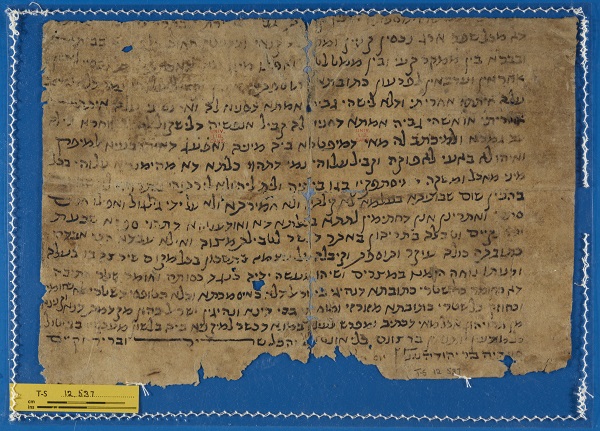
T-S 12.537 verso
Although the date of the ketubba is not preserved, Goitein recognized it as a Mamluk-era document, and his estimate is confirmed by the appearance of the signature of the same witness Seʿadya b. Yehuda on T-S Misc.27.4.22, a document dated 1295 CE. Then, one week ago, as I procrastinated my other work by clicking through images of unstudied documentary Genizah material, I opened T-S NS 264.27 and found the first five lines of a 1298 CE ketubba on recto and a mock medical prescription for lovers on verso—in the hand of Nāṣir. Finally, while drafting this very paragraph, I recalled that my Nāṣir database listed two additional fragments with a ketubba on one side and a mock medical prescription on the other. Lo and behold:
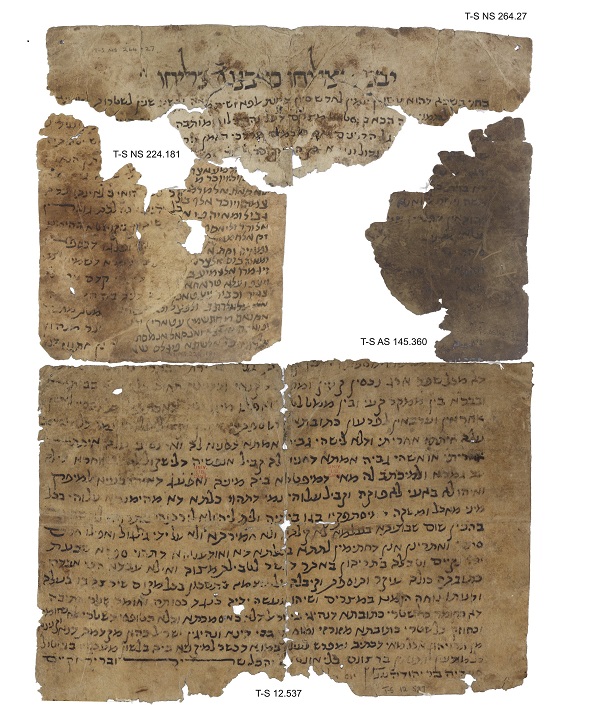
The reconstructed ketubba; text from the verso of T-S NS 224.181 is also visible, as this fragment has not been unfolded
It remains to be seen how much text from the middle portion of the upper half of the ketubba will be legible once T-S NS 224.181 is unfolded. The good news for fans of Nāṣir—and for the lovesick everywhere—is that we now have four nearly complete pages of his prescription:
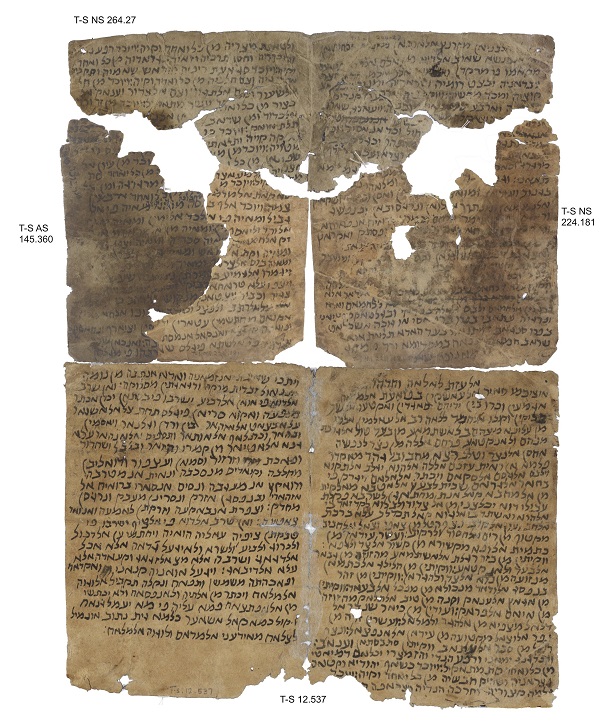
The other side, reconstructed, with T-S NS 224.181 digitally unfolded
Furthermore, we can see how Nāṣir, no earlier than 1298 CE, created a booklet from recycled material. He made a pair of bifolios by first making a horizontal cut across the ketubba and then placing a vertical crease in each of the resulting halves. Probably the upper bifolio nested inside of the lower bifolio, as the lower bifolio contains both the beginning and the end of the text.
Nāṣir, fortunately, was not choosy in his writing material. I have found six similar cases of recycling, each of which helps further flesh out his social context. All of the Arabic-script documents are quite difficult and require further examination.
- T-S Ar.35.223: Legal document in Arabic script. Perhaps a rental contract for Abū Muḥammad b. Abī l-ʿIzz. Appears to be dated 694 AH, which is 1295/96 CE.
- Bodl. MS heb. b 3/30: Petition in Arabic script. Subject matter unclear. Appears to be dated Jumādā I 702 AH, which is 1302/03 CE.
- T-S AS 158.30: Petition in Arabic script. Asking for guidance or orders (waṣāh) having to do with the synagogue at Dammūh.
- ENA NS 8.10: Draft of a petition in Arabic script. The petitioner asks to be exempted from having to go up to the dike.
- T-S NS 113.45 + T-S NS 152.218: Letter of recommendation in Arabic script.15 Abū Yūsuf Munajjā asks the addressee in Alexandria to help the bearer, Abū l-Faraj the scholar.
- T-S 13J21.31: Statute for tenants of the qodesh (communal pious foundation) in Judaeo-Arabic.16 Gil dates the document to ca. 1215 CE, based on his impression that the hand is identical with that of T-S 13J8.11, Bodl. MS heb. c 50/14, and ENA 4011.62v. The handwriting looks quite different to my eye, but, in principle, there is no reason why Nāṣir couldn’t have reused a century-old document.
We can further contextualize Nāṣir based on people and events mentioned within his literary works. The most frequently named person in his corpus is Nāṣir himself.17 But others may be identifiable. In T-S NS 38.32, he narrates a squabble of some kind, repeating the punchline “but they didn’t leave me.” Then, as the conflict escalates, “If they carry on like this, I’ll go to the chief (al-Rayyis) and tell him all my woes, ‘Hey Rabbi Avraham, by God, look at my state!’”18 While the narrative might be fictional, petitioning the head of the community for redress is a detail from everyday experience. The Rayyis Avraham who fits Nāṣir’s timeline is likely the Nagid Avraham b. David b. Avraham b. Moshe Maimonides, the Head of the Jews in Egypt ca. 1300–13 CE.19 Other dignitaries are named in T-S AS 129.86, including Yefet Rosh Qehillot, Avraham Sar [...], Yiṣḥaq, Yehuda, and Moshe.20 Lastly, T-S NS 146.106, a Hebrew poem bemoaning the pain of separation, appears to address the city of Tyre and its sages (this requires further examination).
As for the literary interests and influences that shaped Nāṣir’s style, we often find him copying the works of earlier poets and, at least in one case, a non-poetic literary text:
- T-S NS 260.39: The Midrash of Solomon’s throne, containing passages also found in T-S Ar.16.25 and T-S Ar.18(2).115, fol. 3 (identification and references by Oded Zinger).21
- T-S AS 171.77: An Arabic poem by Bahāʾ al-Dīn Zuhayr (d. 1258) (identification by Hamzeh AlMaayteh). As we do not know what Nāṣir’s Arabic script handwriting looks like, this could either be a copy in his own hand or it could simply be a reuse.
- ENA 2875.31–32: Multiple Hebrew poems, including one by Avraham Ibn ʿEzra.
- Halper 321: A Hebrew wine-water debate poem by a certain Yehuda b. Eliyyahu (at least according to the acrostic). The same poem appears in T-S 8K15.9.22
- T-S K25.276: A Judaeo-Arabic poem, many of whose lines begin with Yā Nafs. Potentially related to the poems discussed by Hasson in her September 2020 Fragment of the Month.23
I have no doubt that a great amount of material related to Nāṣir has yet to be discovered. All of the fragments I’ve found thus far may be accessed at this link on the Princeton Geniza Project. About two-thirds of these were offered by the Joins Suggestions algorithm on FGP, and the remaining third came from open-ended browsing. If you find yourself squinting at a cryptic composition in Judaeo-Arabic and/or Hebrew with rhyme words followed by colons and with lameds shaped a bit like Harry Potter’s scar, you may very well be looking at his handiwork. I would be grateful to learn of your discovery and add your new manuscript to the heap.
I conclude with an edition of the first page of Nāṣir’s medical prescriptions for the lovesick (T-S 12.537). This transcription is based on Goitein’s but has extensive emendations. I have followed the general style of the Princeton Geniza Project in omitting the diacritical marks found in the manuscript. I have not followed the lineation of the manuscript, so as to better convey the rhythm of the text. To the same end, I’ve added slashes after the rhyme words (the colons are Nāṣir’s). There remain several unresolved ambiguities in both the transcription and the translation.
While this is not the place to analyze this text in depth, a few of its salient features are important to mention.24 This is essentially an abbreviated maqāma (a picaresque tale in rhymed prose), similar to other known maqāmāt in Arabic and Hebrew, both in terms of its overall conceit and its rhetorical techniques.25 Nāṣir has a mischievous habit of taking a religious phrase about God and replacing the divinity with the human beloved (e.g., “prostrate yourselves before [the beautiful]”).26 This mild irreverence is of a piece with the extreme irreverence found in a 13th-century Arabic maqāma on same-sex marriage recently published by Maurice Pomerantz.27 The maqāma that most closely resembles the text edited here is probably the 48th maqāma of the Taḥkemoni of Yehuda al-Ḥarizi (d. 1225), centered on a mock medical prescription for a lovesick man.28 The two texts are astonishingly similar, though it does not appear that they share any phrases verbatim.29 The relationship between these maqāmāt, and whether Nāṣir’s version might be considered a link between the Arabic and the Hebrew maqāma traditions, deserves futher study.
אלעזת לאלאה וחדהו
אוציכמו סאיר אלעאשקין / בטאעת אלמ[ל]אח אגמעין
וכרו בין ידיהם סאגדין / ואקטעו אלשך בליקין / וקולו אלחמד ללאה רב אלעאלמין
אלדי מן עלינא מעהם בלאשתמאע30/ מן בעד טול אלגרבת מנהם ולאנקטאע
פרחם אללה מן נצר לנפשה אחסן אלנצר / וטלב רצא מחבובו גהד מא קדר
פלמא אן ראית עזכם אללה אלהוא / יגלב אלתקוא
וילבס אלגסם אלסקאם / ויכתר אלאלאם / ויגרק פי בחאר אלגראם
שכית לבעץ אלאטבא / מא לקית מן אלמחבא
קאל אנת מחתאגן לשרבא
פקלת עבילי דוא / יכלצני מן אלצדוד ולבלוא
לקד זאד בי אלהוא / ואשתד בי אלגוא
קאל תכד לך עלא ברכת אלחב ועון אלקלב
נצף רטל מן צאפי וצאל אלחביב / מקטוף מן ריס אלחסוד ולרקיב :
ועשר עידאן מן כתמית אלופא / מקשורא מן קשור אלצד ולגפא :
ווקיתין מן בזר רגלת אלאשתמאע / מהזוזה מן גבאר אלבעד ולאנקטאע :
ווקיתין מן הלילג אלכתמאן / מנזועה מן נוא אלצד ולהגראן :
ווקיתין מן זהר בנפסג אלודאד / מנכולא מן מנכל אלבעאד :
ווקיתין מן אגאץ אלענאק / וקנה מן טיב אלתלאק / מהזוזה מן איאם אלפראק :
ועודין מן כיאר שנבר אלדלאל / מצפיא מן אלהגר ולמלאל :
ועשרין זרה מן גפר(?) אלוצאל / מקטועה מן עידאן אלאנפצאל :
ונצף רטל מן סכר אלעתאב / ווקיתין סת בסתאן וענאב :
ויוכד גנג ימאני / ורפע הנדי / והז מצרי / וכלאם דמיאטי / מן כל ואחד סת מתאקיל :
ויוכד כשאף יהודיא / וקטאם נצראניה / ושהיק חבשיה / מן כל ואחד וקיה :
ויוכד גלמה קצוריה / וחרכה הנדיה / וצראפה . [ . . . . .
Glory be to God alone.
I exhort you, o lovers, to pledge fealty to the beautiful.
Prostrate yourselves before them, dispel doubt with certainty, and say, “Praise be to the Lord
Who bestowed union upon us after long estrangement and division”—
May God favor the one who looks after his needs, who strives his utmost to gratify his beloved.
When I experienced, dear listeners, how passion overcomes piety,
Wastes the body, increases its pains, and drowns it in the seas of ardor,
I complained to a doctor of my symptoms of love.
He said, “You need a potion,”
So I said, “Fix me a medicine that will save me from discord and distress,
For my passion is unbearable, and my pangs are powerful.”
He said, “Take, with the blessing of Love and the aid of the Heart,
½ pound pure lovers’ union, picked from the heads of the envier and the censor :
10 stalks marshmallow of fidelity, peeled of the husks of discord and scorn :
2 ounces purslane seeds of union, shaken of the dust of distance and division :
2 ounces myrobalan of secrecy, pitted of the kernels of discord and exile :
2 ounces violet of amorousness, sifted of the bran of parting :
2 ounces embracers’ plum and galbanum of coupling, shaken of the days of separation :
2 sticks cassia of coquetry, purged of abandonment and listlessness :
20 buds [...] of union, pruned of the branches of disunion :
½ pound sugar of reproof, 2 ounces garden lady(?) and jujube :
6 measures each Yemeni flirtation, Indian erectness, Cairene quivering, Damiettan pillow talk :
1 ounce each Jewish striptease, Christian lust, Abyssinian moans :
[...] courtiers’ debauchery, Indian dancing, [...] grace….” :
Footnotes
1 ENA NS 8.10, image provided by the Library of the Jewish Theological Seminary.
2 T-S Ar.35.223.
3 There is a major caveat: short of finding his signature at the end of a poem or an attribution of a text to a different author, we cannot be certain about authorship.
4 Dirges: T-S 13J21.31, T-S AS 165.123. Festive songs: BL OR 5557P.47, Moss. II,173, T-S AS 171.77, T-S NS 113.45 + T-S NS 152.218. Erotic odes: Bodl. MS heb. b 3/30, ENA 2700.25–26, ENA NS 8.10, JRL SERIES B 4144, T-S AS 159.242. Parodic medical prescriptions: T-S NS 264.27 + T-S AS 145.360 + T-S NS 224.181 + T-S 12.537. Stingy hosts and tactless guests: T-S AS 158.30, T-S NS 38.32. Biblical tales: T-S Ar.7.24, T-S NS 131.29 + T-S NS 224.143. Fava bean vendors (fawwālīn) and basketmakers (qaffāṣīn): T-S Ar.30.197. Debate poems: Halper 321 (wine vs. water), PER H 134 (wine vs. hashish).
5 Mohamed A. H. Ahmed is the principal investigator of the European Research Council-funded project “Arabic Poetry in the Cairo Genizah” (2020–25). See M.A.H. Ahmed, “An Initial Survey of Arabic Poetry in the Cairo Genizah,” Al-Masāq 30:2 (2018), pp. 212–33, and M.A.H. Ahmed, “Judaeo-Arabic Poetry in the Cairo Genizah: T-S Ar.37.127,” Fragment of the Month (March 2018). See also the publications of Rachel Hasson, including Hasson, “Yā Nafs – A Judaeo-Arabic Reproof for Yom Kippur (?): RNL Yevr.-Arab. II:2682 and T-S Ar.36.134,” Fragment of the Month (September 2020).
6 E.g., William Brinner, “Popular Literature in Medieval Jewish Arabic,” in Judaeo-Arabic Studies, ed. Norman Golb (Routledge, 1997), 70. These footnotes sometimes lead to the manuscript Vat.ebr.411, which contains 8 poems in what is likely Sicilian Arabic or Maltese (written in Hebrew script) from around the 15th century. Godfrey Wettinger, “Late Medieval Judaeo-Arabic Poetry in Vatican MS. 411: Links with Matese and Sicilian Arabic,” Journal of Maltese Studies 13 (1979), 1–16.
7 On Shabazian poetry and Yemeni Jewish poetry more broadly, begin with the publications of Yosef Tobi, e.g., “ʿIvrit, Aramit, ve-ʿAravit be-Shirat Yehude Teman” (Heb.), Peʿamim (1987), 3–22, and Mark Wagner, Like Joseph in Beauty: Yemeni Vernacular Poetry and Arab-Jewish Symbiosis (Leiden, 2009). While macaronic Hebrew/Arabic poetry is not common in the medieval fragments of the Cairo Genizah, there is probably much waiting to be found. Without conducting any kind of systematic survey, I have encountered one such poem in the hand of Nāṣir (T-S NS 207.90) and three in the hands of different scribes: ENA 2700.10, Halper 329 (possibly related to the deposition and later reinstatement of David I Maimonides, in which case it would date to the mid-13th century), and T-S Ar.30.87 (signed by David b. Moshe ha-Levi and dated 1254 CE).
8 “Check out that stoner. . . He looks like a ghoul!” (PER H 134).
9 Li Guo, The Performing Arts in Medieval Islam: Shadow Play and Popular Poetry in Ibn Dāniyāl's Mamluk Cairo (Leiden, 2012).
10 ENA NS 8.10, T-S Ar.7.24, T-S NS 264.27 + T-S AS 145.360 + T-S NS 224.181 + T-S 12.537.
11 Rachel Hasson, “Qiṣṣat al-Miṣrī wa-l-Rīfī: Shir ʿAmami be-ʿAravit Yehudit me-Osef Firkovich” (Heb.), in ʿIyyunim be-Tarbut ha-ʿAravit ha-Yehudit, ed. Yoram Erder et al. (Tel Aviv, 2014), 209–33.
12 According to Victor Lebedev, this bifolio may belong together with a larger manuscript in the Firkovich Collection (no shelfmark given) about the war between cats and mice. Victor Lebedev, “Cats, Mice, Thieves and Heroes in ‘Arabian Nights’ Genizah Tales,” Genizah Fragments 24 (1992).
13 Goitein’s index card, his original transcription, and his transcription with my emendations may all be found at https://geniza.princeton.edu/pgpsearch/?a=object&id=3177. (Ignore the fact that the main shelfmark listed there is T-S NS 264.27, which is on account of ongoing renovations of the Princeton Geniza Project technical infrastructure and website.)
14 My thanks to Michael Rand for this insight.
15 Join by Oded Zinger. Ed. Zinger and Naïm Vanthieghem. My thanks to Zinger and Vanthieghem for sharing their pre-publication edition with me.
16 . Moshe Gil, Documents of the Jewish Pious Foundations from the Cairo Geniza (Leiden,, 1976), 411, doc. 112.
17 ENA 3216.7, ENA NS 8.10, JRL SERIES B 4144, PER H 134, T-S Ar.7.24, and T-S Ar.35.223.
18 T-S NS 38.32. The other side refers to people who “died in the scarcity (ghalāʾ),” perhaps also referring to a known event from recent memory.
19 S. M. Stern, Maimonidis Commentarius in Mischnam, vol. 3 (Copenhagen, 1966), 45. Cf. T-S 8J23.15, by Nāṣir, catalogued as a poem in honor of Rabbi Avraham.
20 T-S AS 129.86.
21 Briefly mentioned in Zinger, “Meanderings in the Arabic Literary Genizot: New Texts and New Contexts,” Intellectual History of the Islamicate World 8 (2020) 188–223, at 203
22 Identification from Halper catalogue (https://openn.library.upenn.edu/Data/0002/html/h321.html).
23 Rachel Hasson, “Yā Nafs – A Judaeo-Arabic Reproof for Yom Kippur (?): RNL Yevr.-Arab. II:2682 and T-S Ar.36.134,” Fragment of the Month (September 2020).
24 I am indebted to Michael Rand for nearly all of the insights in this paragraph and for his invaluable aid with the edition of the text.
25 An Arabic maqāma on medical themes is edited in Bilal Orfali and Maurice Pomerantz, “A Lost Maqāma of Badīʿ al-Zamān al-Hamaḏānī,” Arabica 60 (2013), 245–71.
26 The Arabic phrase “prostrate yourselves before them” is a Quranic allusion (e.g., 19:58 and 32:15). Similarly, Nāṣir’s “with the blessing of Love and the aid of the Heart” is an allusion to the standard phrase accompanying actual medical prescriptions, “with the blessing of God and His aid.”
27 Maurice Pomerantz, “A Maqāma on Same-Sex Marriage in the Thirteenth Century,” Intellectual History of the Islamicate World (2021), 1–27, esp. 21–23.
28 Yehuda al-Ḥarizi, Taḥkemoni, Yahalom and Katsumata eds. (Jerusalem, 2010), 515–19.
29 A particularly intriguing observation (made to me by Michael Rand) is that the parallelistic structure of the prescription in Nāṣir’s version, where the basic structure is “X amount of [something desirable] without [something undesirable],” is broken up by al-Ḥarizi into two separate prescriptions, the first prescription consisting of the desirable ingredients, the second consisting of the undesirable ones. Elsewhere in Taḥkemoni, al-Ḥarizi uses a similar technique of "breaking up" when he adapts earlier material. See Michael Rand, Studies in the Medieval Hebrew Tradition of the Ḥarīrīan and Ḥarizian Maqama: Maḥberot Eitan ha-Ezraḥi (Leiden, 2021), 116–18.
30 A variant of אגתמאע.
Cite this article
Elbaum, A. (2021). Nāṣir, the Hebrew Littérateur. [Genizah Research Unit, Fragment of the Month, October 2021]. https://doi.org/10.17863/CAM.82613
If you enjoyed this Fragment of the Month, you can find others here.
Contact us: genizah@lib.cam.ac.uk
The manuscripts in this article are part of the Cairo Genizah Collection in Cambridge University Library. To see more items from this collection visit: https://cudl.lib.cam.ac.uk/
